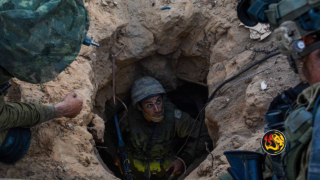Hamas Fighters Trapped in Rafah Tunnels Refuse to Surrender as U.S. Pressures Israel on Ceasefire Deal
Key Facts
- Hamas says fighters trapped in Rafah tunnels on Israeli side “will not surrender.”
- U.S. envoy Steve Witkoff urges Israel to allow safe passage for 150 Hamas members.
- Hamas rejects disarmament under international force, defying U.S. plan.
- Egypt, Turkey, and Qatar propose conflicting mediation paths as ceasefire frays.

(Worthy News) – A group of Hamas fighters trapped inside tunnels on the Israeli-controlled side of the Rafah ceasefire line have vowed not to surrender to Israeli forces, the Al-Qassam Brigades announced Sunday, in a move that could jeopardize the fragile month-old ceasefire in Gaza.
In a statement released early Sunday, the military wing of Hamas said its fighters were “defending themselves” within an area now under Israel Defense Forces (IDF) control, rejecting any notion of surrender and calling on international mediators to intervene.
“The occupation bears full responsibility for the clashes with our fighters in Rafah,” the group said. “Let the enemy know that the principle of surrender and submission does not exist in the Al-Qassam Brigades’ lexicon.”
The statement warned that failure to address the situation could “endanger the continuation of the ceasefire,” while accusing Israel of seeking “flimsy pretexts” to resume hostilities—though Hamas itself has violated the truce several times in recent days. On Saturday alone, two Hamas terrorists were killed after crossing the “Yellow Line,” the demarcation of the ceasefire boundary.
Dispute Over Hostage Remains and Safe Passage Proposal
Hamas also said it requires “additional teams and technical equipment” to recover the remaining bodies of deceased hostages, claiming that operations have been conducted “under extremely difficult circumstances.” The group emphasized that it had “fulfilled its obligations under the agreement,” though Israel has accused Hamas of deliberately delaying returns.
Meanwhile, both Israeli and U.S. outlets report that Washington is pressing Jerusalem to permit the safe passage of nearly 150 trapped Hamas members from the Rafah area as part of a deal to advance the ceasefire’s next phase.
U.S. President Donald Trump’s special envoy, Steve Witkoff, expected in Israel Monday with Trump advisor Jared Kushner, has been urging Israeli Prime Minister Benjamin Netanyahu to agree to the plan. Witkoff said last week that Hamas had previously signaled willingness to disarm.
“Hamas has always indicated that they would disarm. They said it to us directly during that famous meeting that Jared had with them,” Witkoff told attendees at the America Business Forum in Miami. “If they keep their word, the development plan we have for Gaza is really terrific—a lot better than anyone has ever discussed before.”
However, Hamas has publicly rejected any disarmament under an international stabilization force (ISF), insisting its weapons would only be turned over to the government of a future Palestinian state. This stance directly contradicts Witkoff’s comments, where he claimed Hamas would surrender arms to the ISF.
Mediators Divided on Disarmament and Safe Passage
Reports from Arab media indicate that both Qatar and Turkey—two of the primary mediators of the ceasefire—oppose Hamas’ disarmament. Both countries have criticized Israel for alleged ceasefire violations while largely ignoring multiple Hamas breaches.
Turkey has also claimed to be facilitating humanitarian efforts in Gaza. A senior Turkish official told Reuters that Ankara “successfully facilitated the return of Hadar Goldin’s remains to Israel after 11 years” and is now “working to ensure the safe passage of some 200 Gazan civilians trapped in tunnels.”
Egypt, for its part, has proposed an alternative arrangement: allowing Hamas fighters to surrender their weapons to Egyptian authorities and disclose tunnel locations in exchange for safe passage out of Rafah.
Ceasefire Under Strain
Since the U.S.-brokered ceasefire began on October 10, Rafah has remained a flashpoint. Two attacks on IDF troops have been reported, which Israel blames on Hamas. The group has denied involvement. The area also saw one of the deadliest exchanges since the truce began, with three Israeli soldiers and dozens of Palestinians killed in retaliatory strikes.
Local health officials reported that one Palestinian man was killed in an Israeli airstrike in Bani Suhaila, east of Khan Yunis, though the IDF has not yet commented on the incident.
As tensions simmer and negotiations continue, the trapped Hamas fighters in Rafah have become a test case for whether the ceasefire can survive—and whether Hamas will ever accept true disarmament.
💡 Did you know? One of the best ways you can support Worthy News is by simply leaving a comment and sharing this article.
📢 Social media algorithms push content further when there’s more engagement — so every 👍 like, 💬 comment, and 🔄 share helps more people discover the truth. 🙌
Latest Worthy News
If you are interested in articles produced by Worthy News, please check out our FREE sydication service available to churches or online Christian ministries. To find out more, visit Worthy Plugins.
